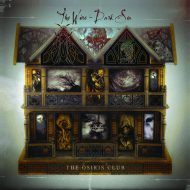 It’s easy to write about an album that’s really good. It’s also easy to write about an album that’s really bad. It’s not so easy to write about an album that’s somewhere in the middle. The Wine-Dark Sea by London’s The Osiris Club is such an album. It’s not exceptionally good, it’s certainly not bad, it’s OK, but to be really good it lacks an edge and a kick.
It’s easy to write about an album that’s really good. It’s also easy to write about an album that’s really bad. It’s not so easy to write about an album that’s somewhere in the middle. The Wine-Dark Sea by London’s The Osiris Club is such an album. It’s not exceptionally good, it’s certainly not bad, it’s OK, but to be really good it lacks an edge and a kick.
Precisely because it lacks an edge one can easily listen to The Wine-Dark Sea. The sound is an unchallenging mixture between Ozric Tentacles and desert rock, or psychedelia and stoner, if you like that better. The tracks are very melodic, often mellow, the singing is clean. Echo on the vocals is almost a constant, adding a bit of grandeur. The arrangement and the production, done in Norway by Anders Møller who has also worked with Ulver, appear somewhat old fashioned, think seventies rock, but, according to the press info, this is exactly the sound the band wanted. Representative tracks are Wormwood Grange, The Hopeless Distance and Ringing the Changes.
Some of the songs were apparently inspired by the horror stories of Robert Aickman and H.P. Lovecraft, others by the Hellboy comic series. The goal was to create the same spooky and foreboding atmosphere on The Wine-Dark Sea. While I do think that the music on the album evokes an atmosphere of times past, I must say that I don’t find it spooky or foreboding. Not at all, actually. The tracks are far too melodic to be spooky, the tempo is too fast and the singing too nice. One would assume the vocals at least to tremble in terror now and then, if the music is inspired by horror stories, or to display a wider range of emotion, but they stay clear and pretty much even throughout all of the nine tracks.
The album’s artwork has been done by the band’s drummer, Andrew Prestidge, and represents a continuation of the album’s main themes. I like very much the idea of making an album a total work of art, of all parts fitting together, and this has been successfully realized here. The album cover, made in collaboration with Julia Harris, features a doll house that has bits of images of skulls, insects, trees, roots and animals as wallpaper. Whether intended or not, it can be interpreted as a representation of Lovecraft’s stories. An art nouveau detail connects it to the time in which Lovecraft was born and has lived. However, the whole composition is a bit too static. There is nothing going on, no action, no movement.
The Wine-Dark Sea, I find, lacks something that reels you in and makes you engage with it the way a very good album does. It evokes primarily an atmosphere of times gone by, of drama, of grandeur, but I don’t see or hear horror, terror od trauma. It’s all pretty smooth. The band photo featuring five guys wearing Iong, black robes with a gilded stripe across the chest, a thunderstorm brewing behind them, fits right into the described atmosphere. They look like priests of some kind of cult, but too friendly and too much part of this time and age to provoke a strong reaction in the viewer.
(7/10 Slavica)

Leave a Reply